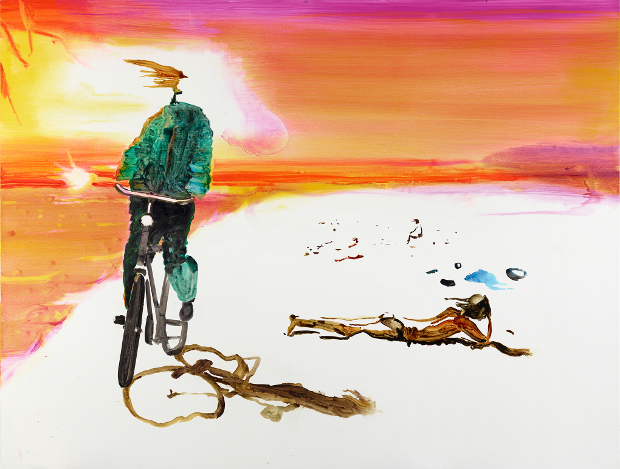John Kørner: Fallen Fruit from Frisland at Victoria Miro

Victoria Miro gallery is currently host to John Kørner’s third solo exhibition, Fallen Fruit from Frisland. Its title refers to the coastal area running along the lower border of Denmark, where the artist’s great grandfather built boats. The construction of one such boat and its subsequent preservation in a museum was the main source of inspiration for the works of art shown, which include nine paintings and a mixed media installation made from, among other things, an old vessel just like Kørner’s ancestor’s.
All the artworks are indeed influenced by that peculiar geographical region which, before the construction of canals in the 1920s, was often flooded (hence the need for boats to travel from a place to another). This is immediately obvious on entering the gallery, as visitors seem engulfed by the floor they step on, which at the other end curves to form a giant, distressing wave reminiscent of those sweeping Frisian shores long ago. The wave is covered with a carpet whose geometrical pattern further enhances the sense of anguish, while simultaneously distancing spectators. This first objet d’art, which places viewers in medias res,is called Into Eternity and is completed by the presence of the aforementioned vessel, containing cylindrical ceramic forms, perhaps referring to that everlasting bond we all have with our forebears.
Connections with the past are also seen in the painting Apples and Boys, which seems to allude to the Original Sin. The apples look unrealistically big as they fall from the trees, evoking once again a feeling of apocalyptic distress. The artist uses only dark colours to depict the scene on half of the canvas.
The same mood pervades other works like 12 O’clock at the Beach, where we see a human being at the foreground whose face has melted and blended with the blinding light of the sun. Another person (hardly recognisable as a female, with a body more like a skeleton) lies behind on the beach, and a third figure farther away seems to float on the white sand; all against an inflamed sky.
There are less disquieting paintings, such as Frisland After Rain, where the landscape represented ends up softening, as if dissolving in a merging of all natural elements, whose pastel-like colours do not necessarily predict catastrophic consequences. Overall, though, Kørner’s new exhibition speaks to us as symbolic of life’s tides and constant change in a vicious circle of creation and destruction, reminding us that everything is connected.
Rita Vicinanza
Fallen Fruit from Frisland is at the Victoria Miro Gallery until 2nd March 2013. For further information visit the gallery’s website here.























Facebook
Twitter
Instagram
YouTube
RSS